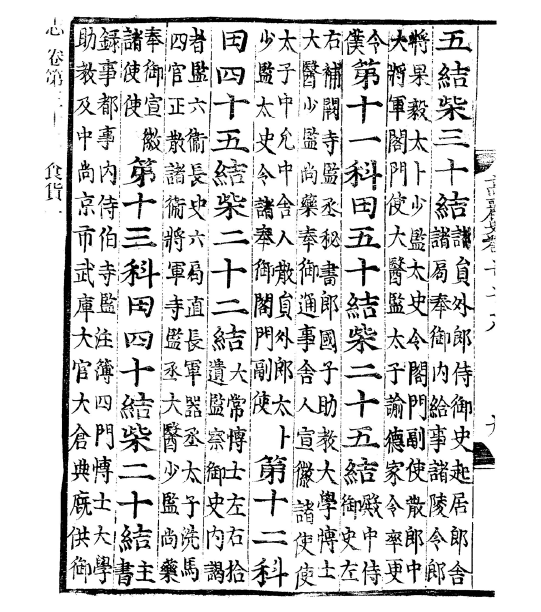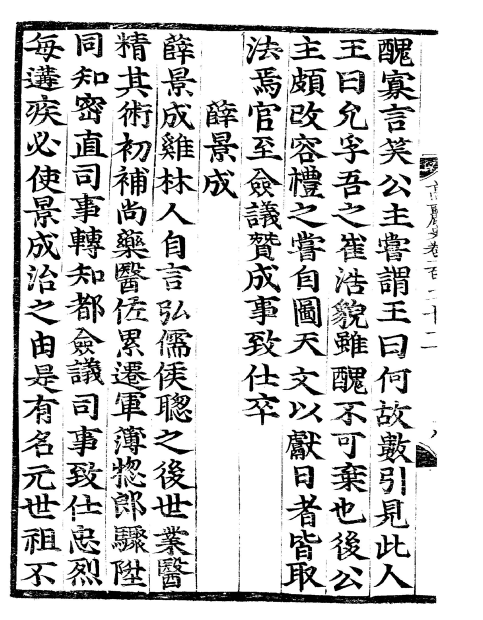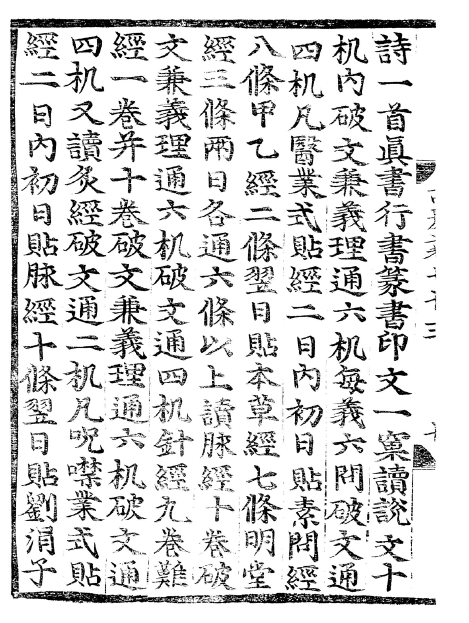INTRODUCTION
This article examines the Korean Goryeo Dynasty’s medical licensing system (uieop) for becoming a physician officer. Because medical care for the common people did not require a medical license, the medical licensing examination during the Goryeo Dynasty (918-1392) was not equivalent to the present examination. Rather, it was a system to promote applicants to physician officers, who could work in the palace and the government’s medical institutions. This paper will address three aspects of the medical licensing examination: first, the implementation of the examination to be a physician officer and the establishment of the medical institutions where officers worked; second, developments in the medical licensing examination system until the end of the Goryeo Dynasty and changes in qualification for the applicants; third, medical books of the Goryeo Dynasty and the subjects covered by the medical licensing examination. All of this should be useful for understanding the history of medical training and the medical licensing examination during the Goryeo Dynasty.
ESTABLISHMENT OF THE MEDICAL LICENSING EXAMINATION AND THE HEALTH CARE INSTITUTIONS IN THE REIGN OF KING GWANGJONG (949-975)
No records remain of a medical licensing system in the Three Kingdoms Period prior to the Goryeo Dynasty, but a few extant records do mention medical education in the Silla Dynasty. Medicine of the Chinese Dang Dynasty had an absolute influence over the Korean system of the Silla Dynasty. The earliest of the Goryeo Dynasty’s healthcare records was an article mentioning that physician officers were placed in every province (gunhyeon) when the Goryeo Dynasty was founded; however, the exact date was not mentioned. The earliest known dated record was that in 930, King Taejo, founder of the Goryeo Dynasty, had visited the city of Seogyeong (present Pyeongyang city) and had encouraged medical education by setting up a medical school there for the first time. He established a private institute that taught the students from different provinces together. The King later heard that they studied hard, so he encouraged them by sending them silk as a reward. It was during the reign of King Gwangjong (949-975) when healthcare-related government initiatives were first described. These healthcare-related actions included implementation of a medical licensing examination (uieop), operation of a medical institute (Sanguiwon), and establishment of public charity (Jewibo). The medical licensing examination came into effect in 958. Three physician officers were recruited in 960. The subjects covered by the examination during the reign of King Gwangjong were the same as those from Silla’s medical books. This exam was challenging, as evidenced by the fact that there was a student reported to have studied for twenty years to apply to the exam in 999. Examinees had studied in the medical education institute since the beginning of the Goryeo Dynasty, and they seemed to be trained enough to practice in the field. The civil service examination (gwageo) was given frequently during the period of King Seongjong’s reign, and physician officers were recruited in 987 and 988.
The healthcare institutions could be classified into those of the capital and local areas. They could also be classified as public and upper-class healthcare institutions. Of the Goryeo Dynasty’s healthcare institutions in the capital, the Government Hospital (Taeuigam) and Pharmacy for the King (Sangyakguk) were representative as the government’s institutions for the upper class. Public charity (Jewibo), the Institution for the Relief of the Aged and Infirm Poor (Dongseodaebiwon), and the Therapeutic and Disease Control Center (Hyeminguk) were established for the common people.
TITLE OF PHYSICIAN OFFICER (EUJIK) AND THEIR SALARY
Physician officers were paid with farms and forests. Physician officers appeared in the land salary system called gaejeongjeonsigwa and gaengjeongjeonsigwa (Fig. 1). Despite the 80-year span of time from the reign of King Mokjong to King Munjong, the system of physician officers underwent little change. The number of general physicians expanded, as shown by the record that acupuncture therapists (jugeumsa) did not appear in the initial land salary system but received land in 1075. Academic physician officers (hallimuigwan) first appeared during the reign of King Munjong (1046-1083), which came about due to the influence of the Chinese Song Dynasty. The existence of acupuncture therapists and academic physician officers is evidence that the development of the Goryeo Dynasty’s healthcare system was affected by the Song Dynasty.
DEVELOPMENT OF THE MEDICAL LICENSING EXAMINATION AND CHANGES IN QUALIFICATION OF APPLICANTS
The medical licensing examination to qualify physician officers of the Goryeo Dynasty was established in 958. King Seongjong (981-997) put extensive effort into the medical licensing examination by seeking qualified applicants and dispatching physician officers to the provinces. Notably, the officer class of the local authorities (hyangri) and the common people could study for the exam. There was an open path for upward class mobility through the licensing examination. Medical education had been continuously encouraged until after the reign of King Seongjong. Although the Goryeo government opened the door of medical education wide to all applicants, in reality, mainly the children of the officer class of the local authorities were able to access the education. Local students who came to the capital city to study during the reign of King Seongjong were mostly the children of that class. The civil service examination system was re-organized by introducing the preliminary examination in 1024 and in 1031. To become a physician officer, it was mandatory to pass the first examination (uieopgamsi) and final examination (dongdangsi). If the applicants were from a local province, they also had to pass a preliminary examination for local applicants (hyanggongsi). Therefore, they had to pass a three-step exam.
The qualification of applicants for the medical licensing examination changed continuously over time. During the reign of King Jeongjong (945-949), the common people were not be able to take civil service examinations. Only the children of the officer class of the local authorities or the aristocratic class were able to take the medical licensing examination. In 1048, even the common people called jablyu could take the medical licensing examination. All the subjects of the civil service examination were opened to the common people except the examinations for court musician (akgong). However, the qualification to take the medical licensing examination was not opened to the common people indefinitely. The record in 1055 showed that people not enrolled in a clan were not allowed to take any civil service examination. To take the exam, their previous four ancestors’ names, government grade, and public office had to be confirmed. After that, in 1125, the promotion of the common people (jablyu) who passed the medical licensing examination was limited to the 7th rank (in a system in which lower rank numbers represented ranks higher in the hierarchy), although they were allowed to earn promotion up to the 4th rank if they had a good reputation or excellent competence.
The civil service examination in the Goryeo Dynasty had functioned as a passage to a better social status for the officer class of the local authorities in the earlier part of Goryeo Dynasty; however, it became difficult for them to obtain a better social status beginning in the middle period of the Goryeo Dynasty since the aristocracy monopolized the exam. The ranking regulation for physician officers provides evidence of the polarization that appeared in the medical field. The Chief of the Government Hospital had held the 3rd rank since King Munjong (1046-1083). In 1125, a regulation stated that those who passed the medical licensing examination could be promoted up to 4th rank (Fig. 2). After the medical licensing examination came to be treated as the technical part of the examination (jabgwa), attitudes toward physician officers was divided into two extremes according to social status. From the perspective of the common people, the medical licensing examination was a gateway to promotion to a higher class by the professional study of medicine in addition to the standing rules for qualification. On the other hand, those from the aristocracy who were enacting limitations on promotion according to class (hanpumseoyong) had no motivation to work in the medical field because only a limited proportion of physician officers could be promoted to top-level officer positions. Eventually, this led to a situation where the common people filled all the positions as physician officers. The Goryeo government’s emphasis on opening the door to class promotion for talented people through the medical licensing examination resulted in medicine becoming rather despised by members of the aristocracy. As a result, while children of the nobility could become a civil minister (munban) through the civil service examination (jesuleop, myeonggyeongeop), the officer class of the local authorities tended to take technical examinations (jabeop) such as the medical licensing examination. The reason that they crowded into the medical licensing examination was that their workload had become troublesome beginning in the 12th century. After the local governing system became unstable in the earlier Goryeo Dynasty, they were not able to maintain leadership in the social order of the country villages. Thus, in the late Goryeo Dynasty, those sitting for the medical licensing examination tended to be monopolized by this local officer class. However, since the Goryeo government wanted to avoid the monopolization of physician officer positions by this single group of people, the officer class of the local authorities were prevented from even taking the medical licensing examination in 1363. This restriction was then strengthened, which was seen as a sign that a unified status-based hierarchy was becoming entrenched in society, without options for merit-based social climbing by outlets such as the physician officer position. The aristocracy’s power was entrenched at the loss of medical development in the late Goryeo Dynasty.
THE SUBJECTS OF THE MEDICAL LICENSING EXAMINATION AND MEDICAL BOOKS
In the Goryeo Dynasty, medical books were essential to prepare for the medical licensing examination or to learn medical techniques. For example, in 1056, the Mayor of Seogyeong requested that medical books be sent from the Palace Library (Biseogak) because the medical books being read by local applicants contained many errors. He was able to get one book in print per request. It is possible that many such books were circulated if the books were not transcribed but printed. The medical books in use during the Goryeo Dynasty reflect the level of medical development of the era. From the 10th to 11th century, 21 government books (gwanpanbon) were published, and many releases were printed during the reigns of King Jeongjong (945-949) and King Munjong (1046-1083). They included ten medical books, five history books, three Confucian classics, and three other titles. Table 1 shows the medical books from the Goryeo Dynasty. Japanese historian Miki Sakae has proposed that those nine medical books were the medical books of China’s Song Dynasty or were based on the editions of the Song Dynasty, arguing that these medical books demonstrate “the flourishing of the Goryeo Dynasty’s medicine.” He concluded that medicine of the Song Dynasty was popular because most of these medical books were “versions of Song Dynasty books [3].” However, most of these books were actually writings from the Chinese Han Dynasty, Su Dynasty, and Dang Dynasty. Only one was a title from the Song Dynasty. Chinese medical books from periods prior to the Song Dynasty were already in circulation during the Goryeo Dynasty. Though the versions of these medical books from the Song Dynasty were imported and were engraved on wood during the Goryeo Dynasty, the import of these versions of the Song Dynasty did not mean the acceptance of the so-called “complete medicine of the Song Dynasty.” Therefore, it can be said that the medical books circulated early in King Munjong’s reign did not contain the complete medical theory of the Song Dynasty. Because the medicine of the Song Dynasty was also constantly evolving, the Goryeo Dynasty wanted to import ”the Song Dynasty’s medicine,” but, in fact, ”Chinese medicine” as it was currently practiced in those days was imported. The other reference that can be used to gauge the influence of the medicine of the Song Dynasty was the record of the medical licensing examination course in the reign of King Injong. The Goryeo Dynasty did not need to follow the medical system of the Song Dynasty, because, from the diplomatic point of view, the North Song Dynasty had already fallen in 1127 and diplomatic ties with the Song Dynasty were also in decline. The record demonstrates the Goryeo Dynasty’s own level of medical development apart from any diplomatic relationship with the Song Dynasty. The Goryeo Dynasty thoroughly adopted the Dang Dynasty’s system for its medical licensing examination despite the study of the Song Dynasty’s medicine since the reign of Munjong (949-975). Goryeo’s medical licensing examination courses followed the tradition of the Silla Dynasty, which imitated the Dang Dynasty’s system (Fig. 3). The Goryeo Dynasty and Song Dynasty had totally different examination systems. The influence of the Song Dynasty’s medicine was, therefore, not great in the Goryeo Dynasty.
CONCLUSION
Physician officers played several important roles during Korea’s Goryeo Dynasty. Unlike the physicians for the common people, who were allowed to practice without a license, the physician officers who served the king and the aristocracy were held to a higher standard of excellence. They had to pass a difficult series of technical examinations that measured their knowledge of the classical books of Chinese Dang Dynasty medicine passed down through earlier Korean Silla Dynasty publications. Thus, through their studies, they maintained the continuity of knowledge of medicine from one generation to the next. However, due to specific government policies of the early Goryeo period, the medical licensing examination system for the physician officer position also provided an opportunity for the brightest of the common people and lower officer classes to climb to an officer’s higher ranking, providing some fluidity in the social hierarchy. Eventually, the aristocracy blocked access to the examination for common people, thereby reducing the pool of candidates and the competition for physician officer positions. This led to the eventual decline in medical innovation during the late Goryeo Dynasty. However, the basic system of medical licensure set the stage for ongoing systemization of the medical profession in future eras.




 PDF
PDF Citation
Citation Print
Print







 XML Download
XML Download